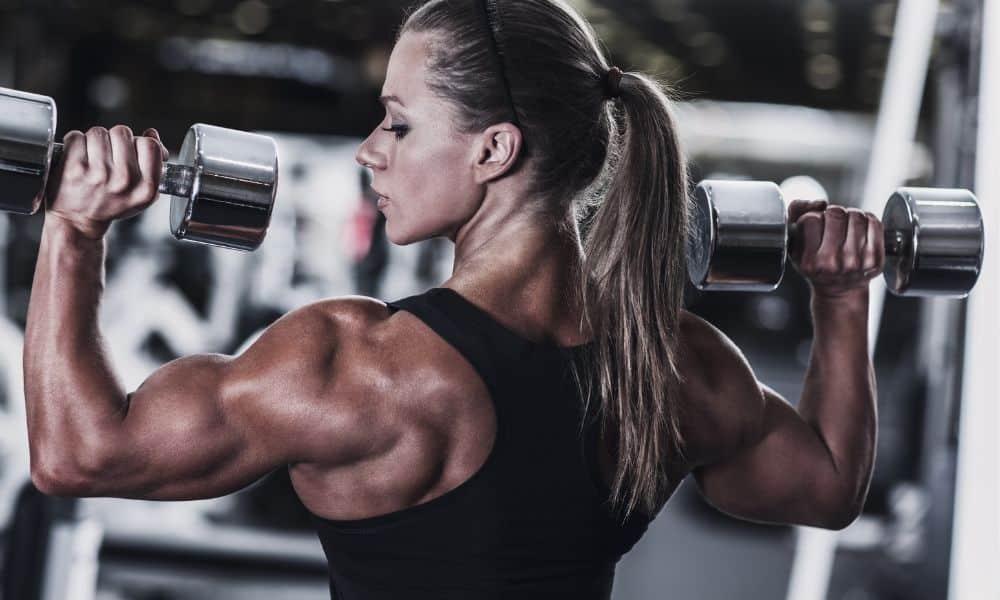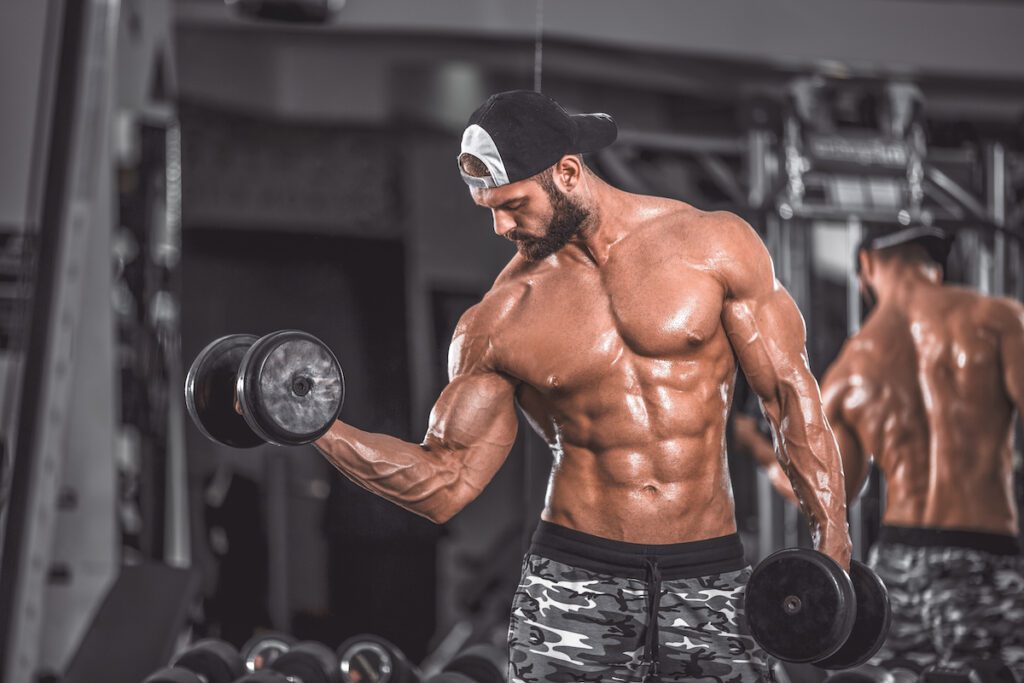Are you looking for a periodization plan for an amateur bodybuilder? This year-long training will prepare an amateur bodybuilder for competition. The goal was to optimize the bodybuilder’s physique just in time for the competition.
Assessments
The first step to any periodization plan is to define the amateur bodybuilder’s goals and complete assessments. This helps to determine goals, programs needed, and how to implement training. The assessments used for this plan address performance, appearance, and genetics.
The first assessment used is one rep max to determine overall strength. Since strength is the foundation for building muscle, the one rep max is used in the core powerlifting exercises. Strength determines how many reps, sets, and weights can be lifted.
The second assessment, the 80% max, determines the bodybuilders’ ability to grow muscle. Again, since they are new to bodybuilding, they can grow muscle faster than experience bodybuilders without PEDs. But since the workout is designed for a new bodybuilder, their muscle recovery will also be compared to new bodybuilders.
A 3D body scanner should be used for the third assessment to represent body metrics visually. This assessment can be performed at a health facility, some health clubs, or a smartphone. A 3D body scanner uses analytical geometry to help the trainer see the correlation between a fitness plan and body composition.
The fourth assessment is lab results. They assess the bodybuilder’s metabolism, hormones, lipids, and overall health. Lab results can be purchased online via Amazon or by a doctor or hormone therapist. Lab results determine what role genetics play during a workout program. Also, the lab results guide the bodybuilder’s diet.
Finally, we need assessments as a baseline or starting point for goals. Also, assessments let us know who we are and where we are at. Therefore, ensuring that the evaluation is objective and measures what it is supposed to measure is important. Therefore correct form and accurate assessments should be performed without emotional bias.
Macrocycle Periodization Plan
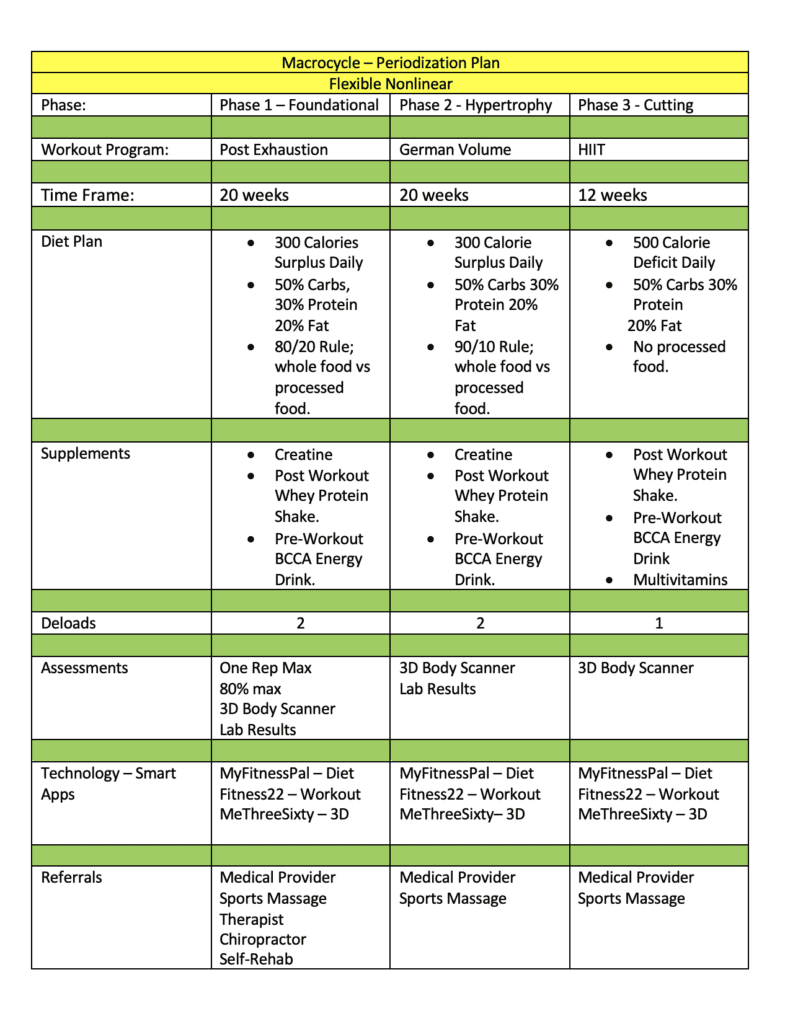
After assessments, amateur bodybuilders select a periodization plan. While bodybuilders help make the selection, a trainer should guide the process by analyzing the assessments and setting goals. A flexible nonlinear periodization plan was adopted based on a novice bodybuilder’s experience level. This type of plan allows training changes based on readiness. The intensity increases when the trainee experiences high energy levels and outperforms the workout program. However, the intensity decreases when the trainee experiences low energy levels and underperforms the workout program.
A flexible nonlinear periodization plan is best for a new bodybuilder due to how fast new bodybuilders grow in strength and size. It allows immediate adjustments, which will save time. Also, A flexible nonlinear periodization plan requires a pre-workout assessment. Therefore, a workout starts with a benchmarking exercise. The benchmark should be a compound lift which most people perform first because of the amount of energy compound lifts require, and that is when the trainer has peak energy levels.
Three Phrases
A periodization plan for an amateur bodybuilder has three phases: foundational, hypertrophy, and cutting. The breakdown of the periodization plan is as follows:
Foundational Phase (20 weeks)
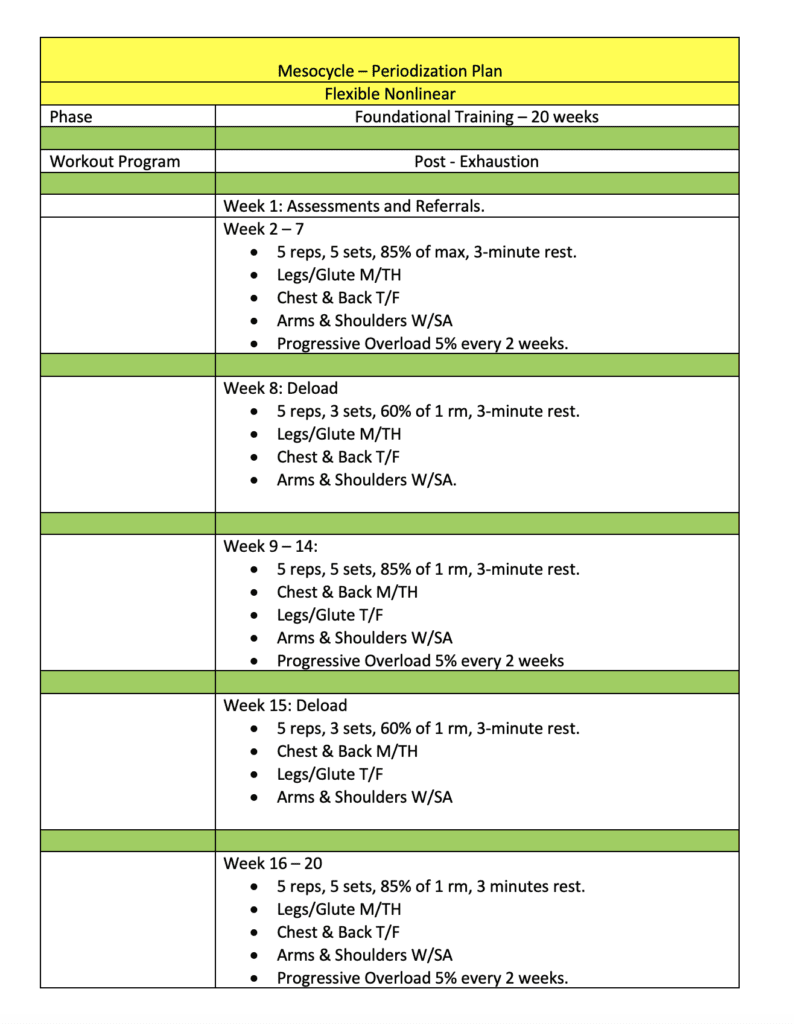
Hypertrophy Phase (20 weeks)
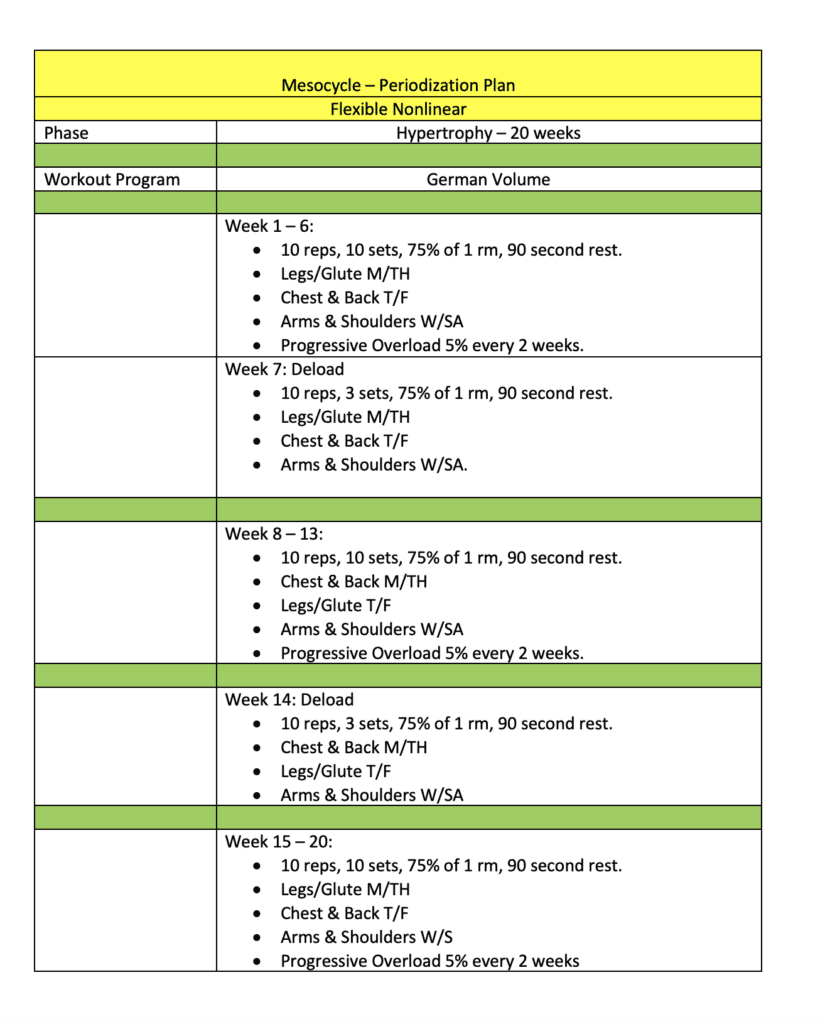
Cutting Phase (12 weeks)
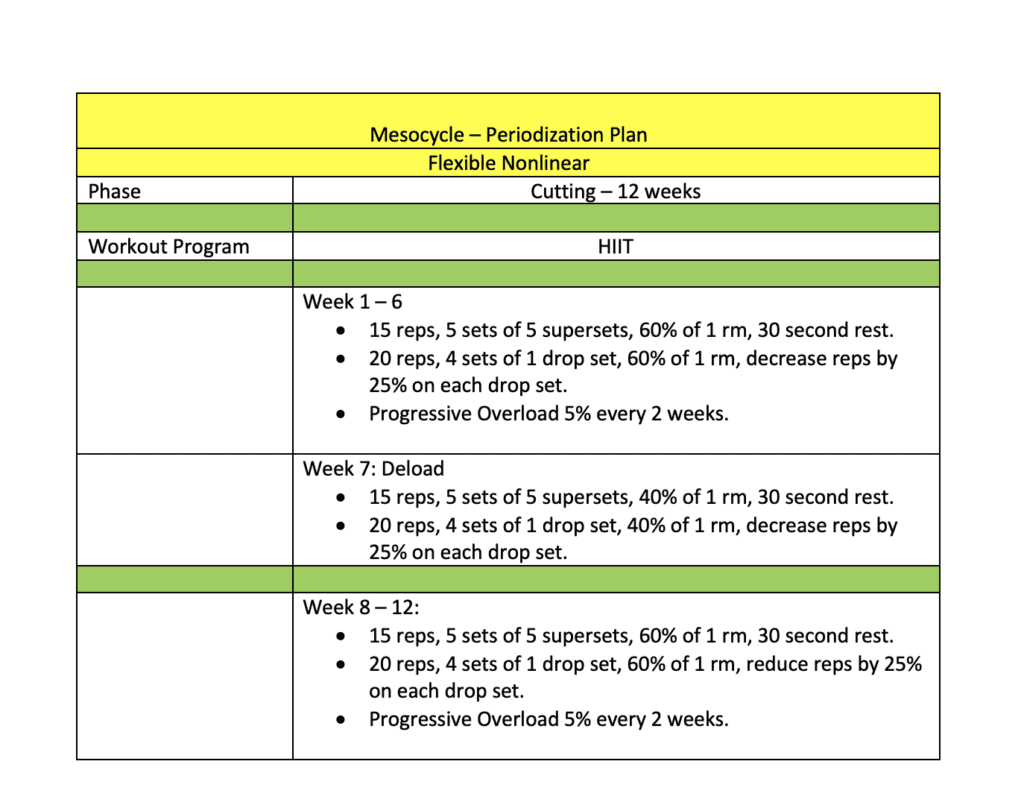
The time is evenly split between the foundational and hypertrophy. Foundational training is about building the strength needed to build muscle. To determine the amount of time used for each phase, the one rep max and 80% max were used. The one rep max and strength guidelines dictate how much time is needed for foundational training. Also, 80% max determines how much time is required to build muscle.
A slower gainer will need more time for hypertrophy training than a fast gainer, decreasing the foundational or cutting phase time. Thus, a more aggressive plan can be devised for a faster gainer, which means more time can be spent on the other phases.
The hypertrophy phase takes more time than the cutting phase, as it is more challenging to build muscle than to cut body fat. While a professional athlete can create one to four pounds of muscle a month with intense elite training, an average person can lose two pounds weekly. Furthermore, fat loss is stressful to the body due to low energy (food). Therefore 12 weeks which is three months, are set aside for cutting body fat.
Workout Program
The workout programs selected were post-exhaustion training for the foundation phase, German volume training for the hypertrophy phase, and high-intensity interval training (HIIT) for the cutting phase.
First, post-exhaustion was selected for the foundation phase for the following reasons: post-exhaustion uses compound exercises to build core strength and isolation exercises to correct strength weaknesses. Because the compound lifts are the focus, they are performed first. This program uses isolation lifts sparingly to save time and maximize growth.
Week 1 – 7: Foundational Training
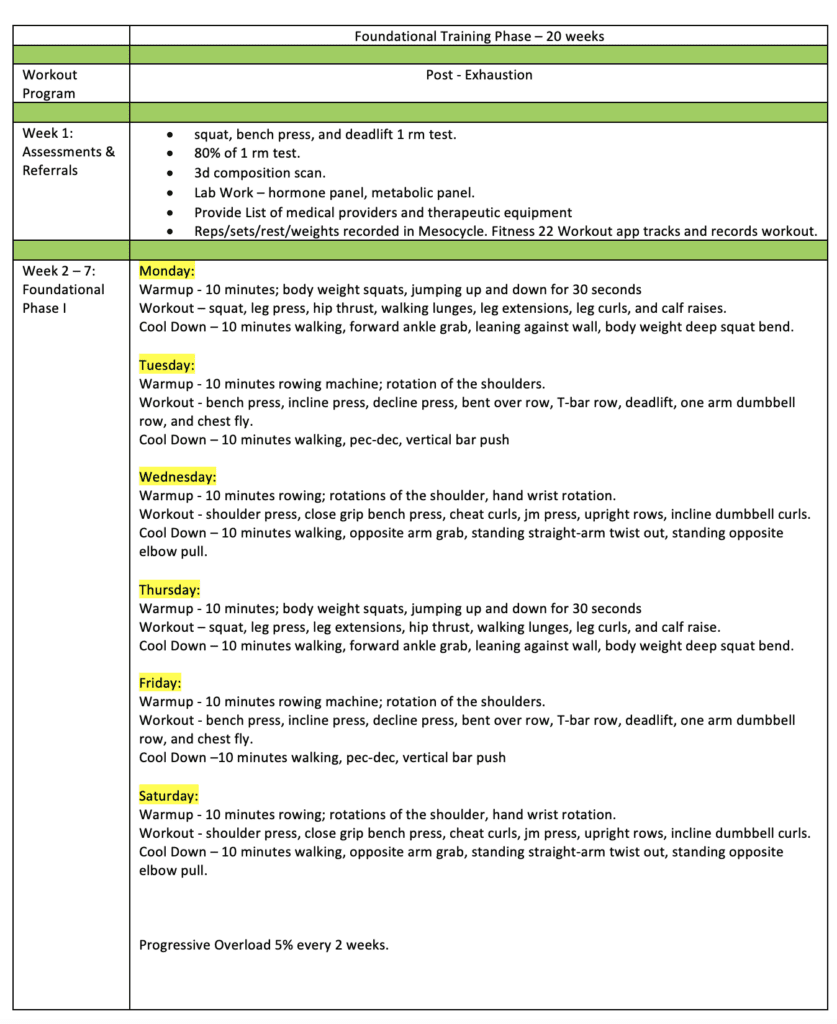
Week 8: Deload
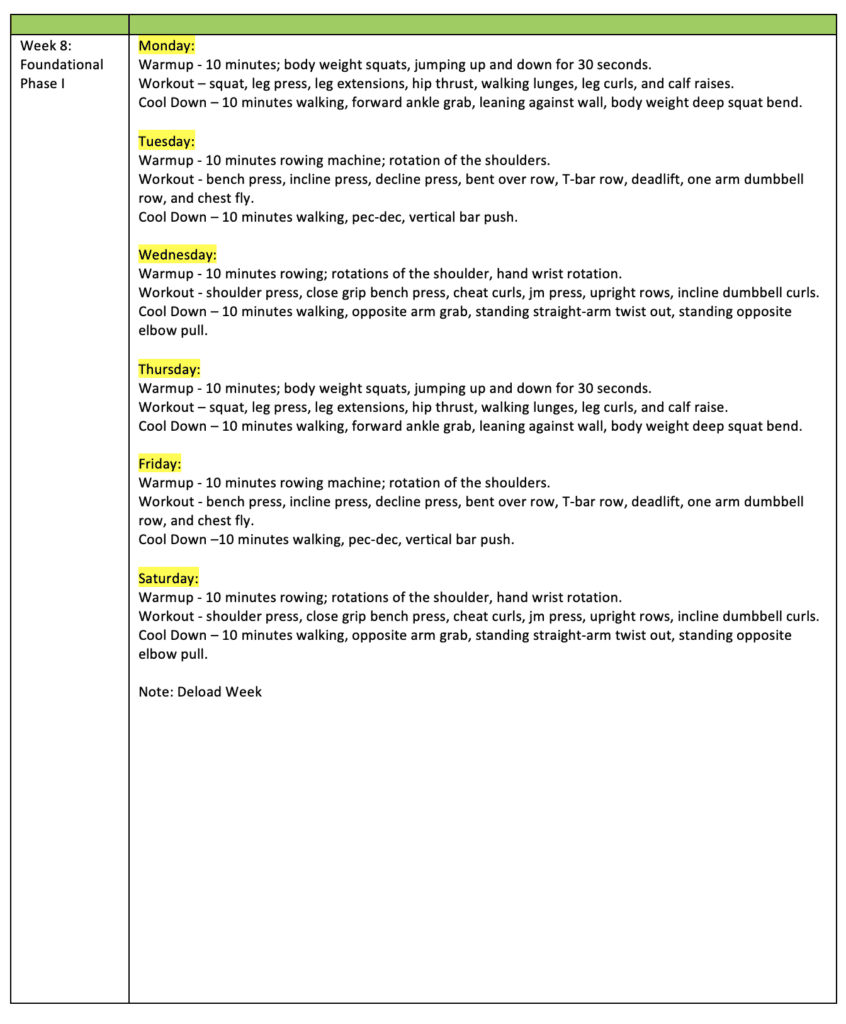
Week 9 -14: Foundational Training
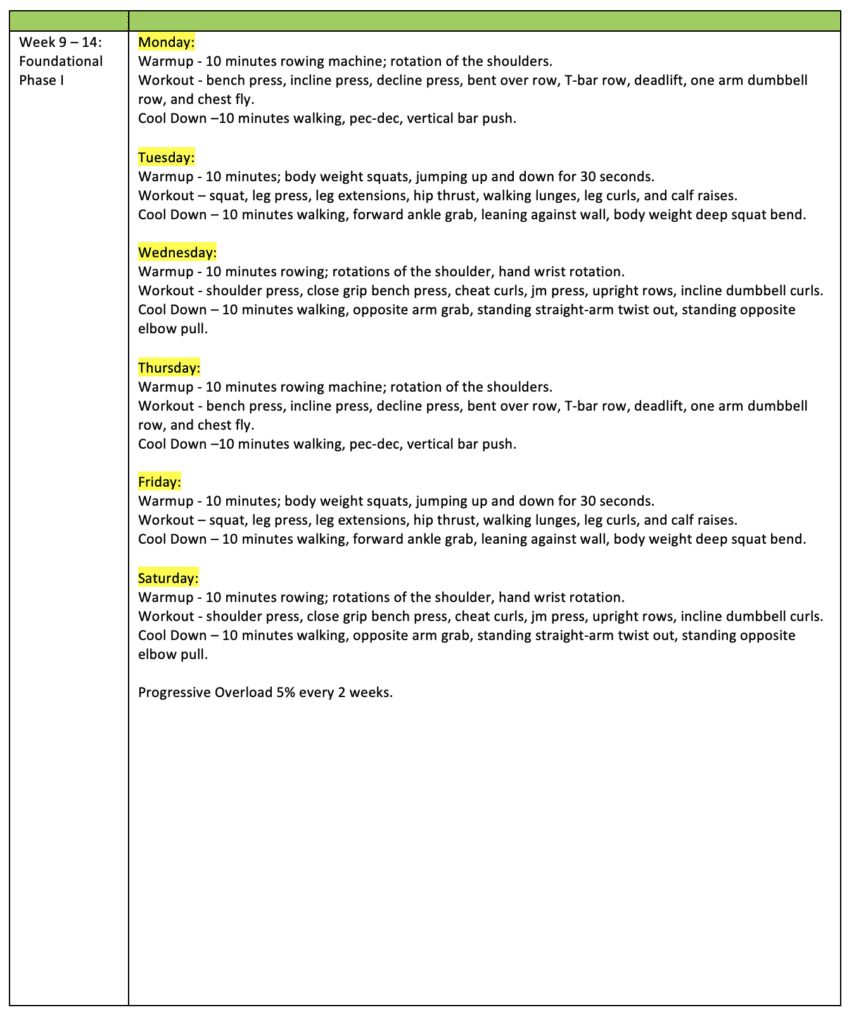
Week 15: Deload
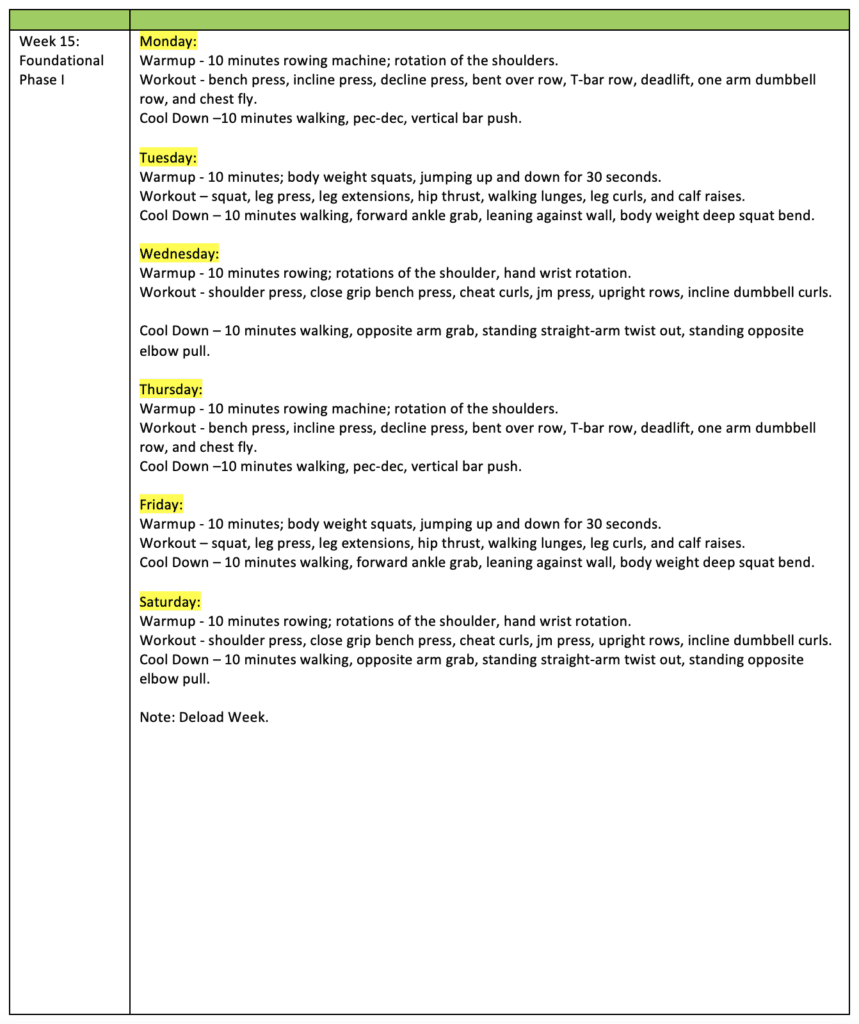
Week 16 – 20: Foundational Training
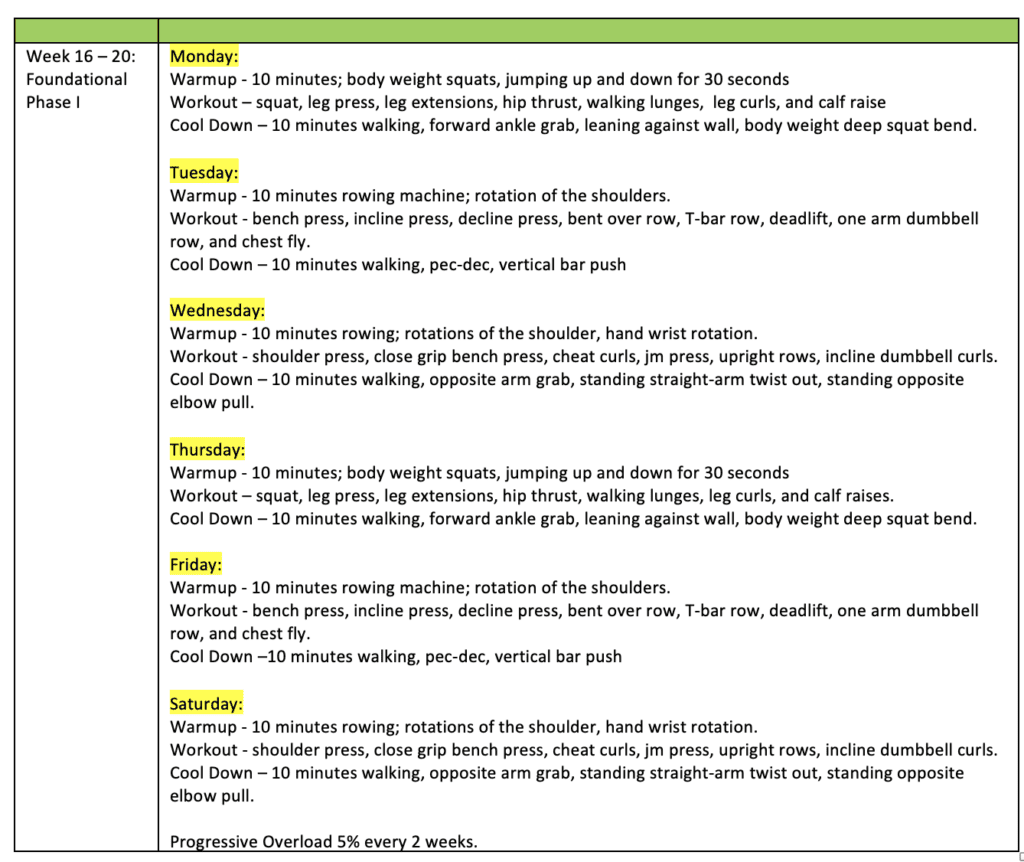
Second, German volume training was selected for the hypertrophy phase for the following reason: German volume training uses ten reps and ten sets for each exercise to produce the amount of volume needed to build muscle. Scientific research shows that the optimum range to build muscle is 8 to 12 reps for each set and 9 to 20 sets each week. Because this program calls for bodybuilders to work a body part two times a week to reach the set range needed to optimize muscle growth, German volume training was the best program. Thus ten sets per exercise twice a week guarantees 20 sets weekly for each activity.
Week 21 – 27: Hypertrophy Training
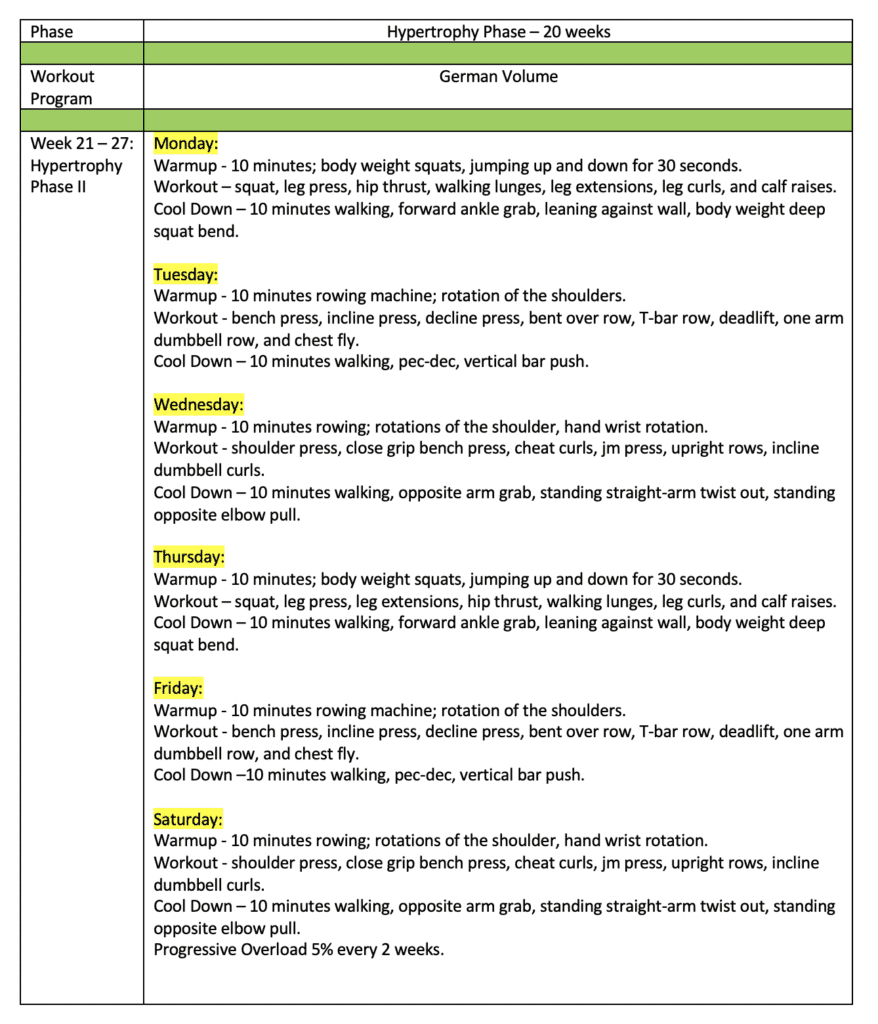
Week 28: Deload
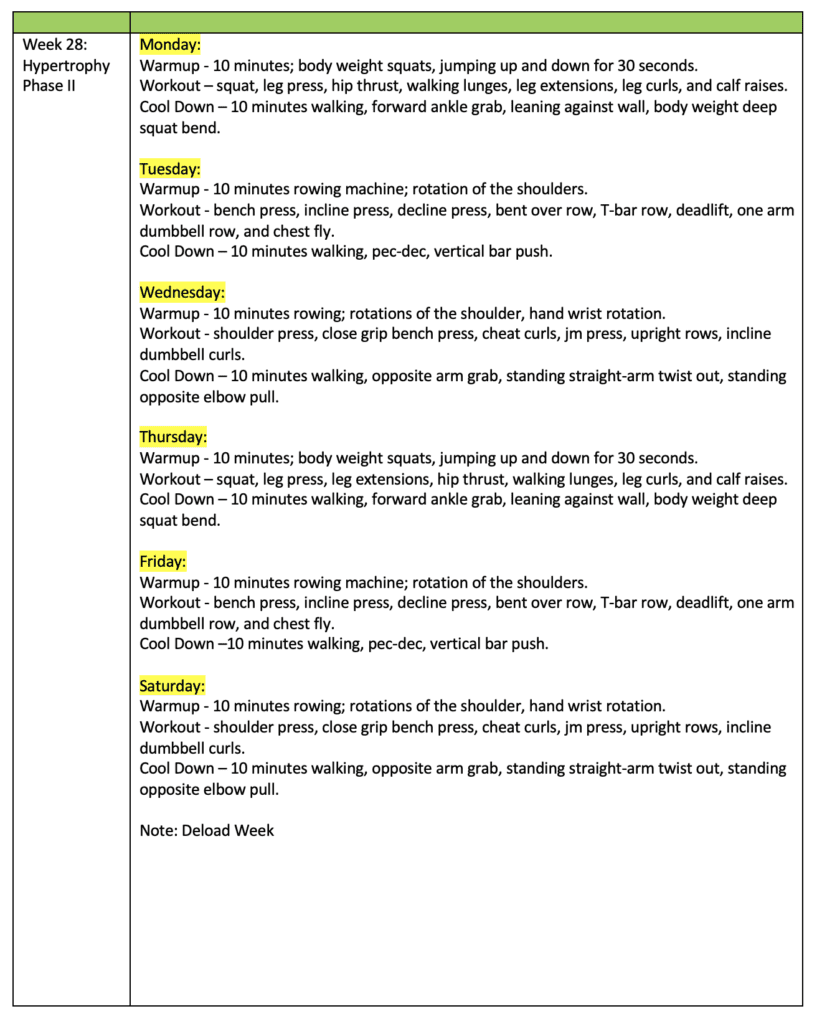
Week 29 – 34: Hypertrophy Training
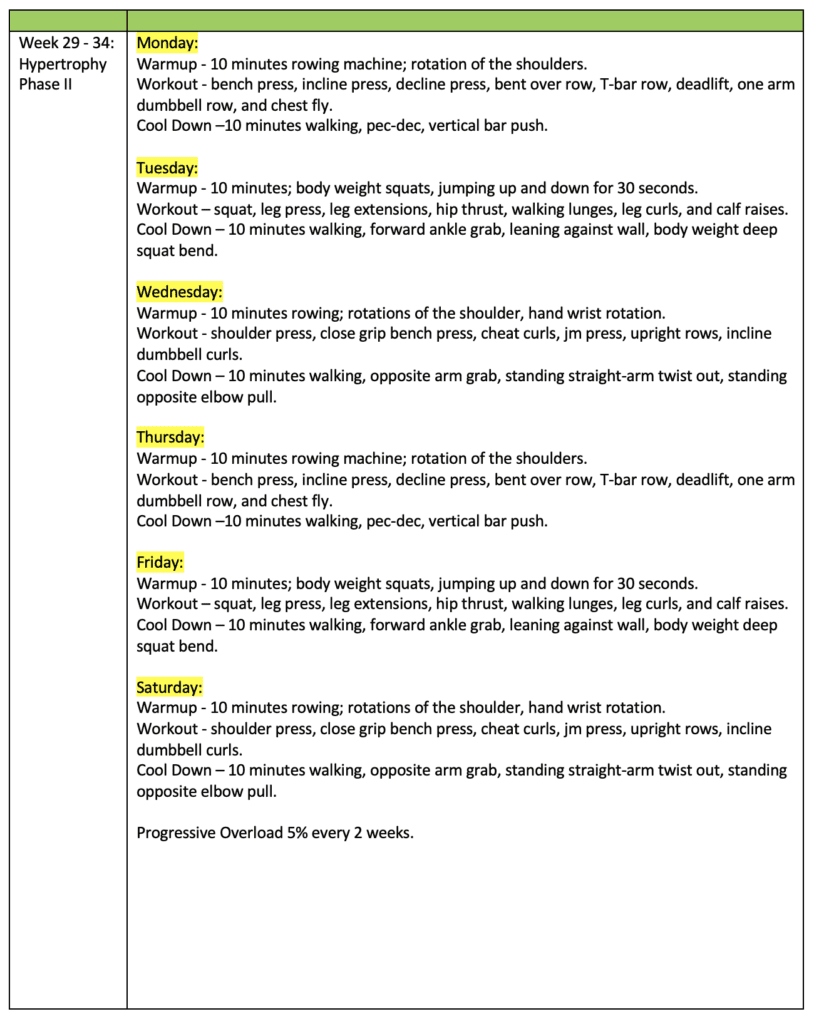
Week 35: Deload
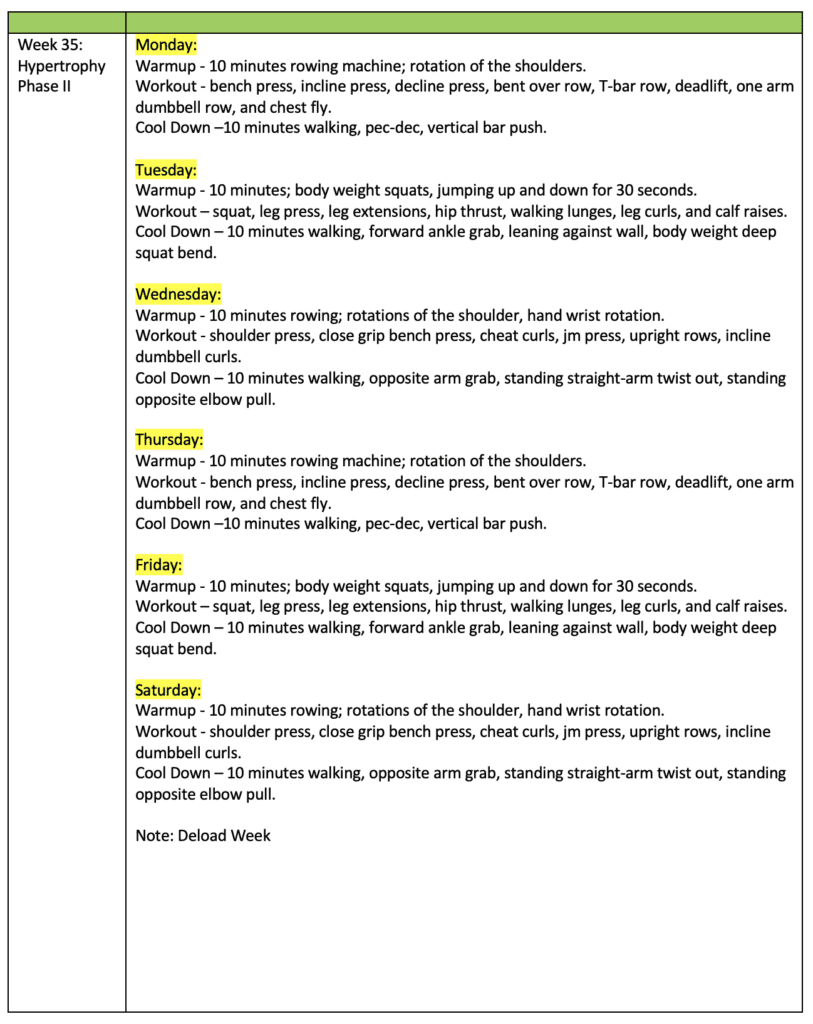
Week 36 – 40: Hypertrophy
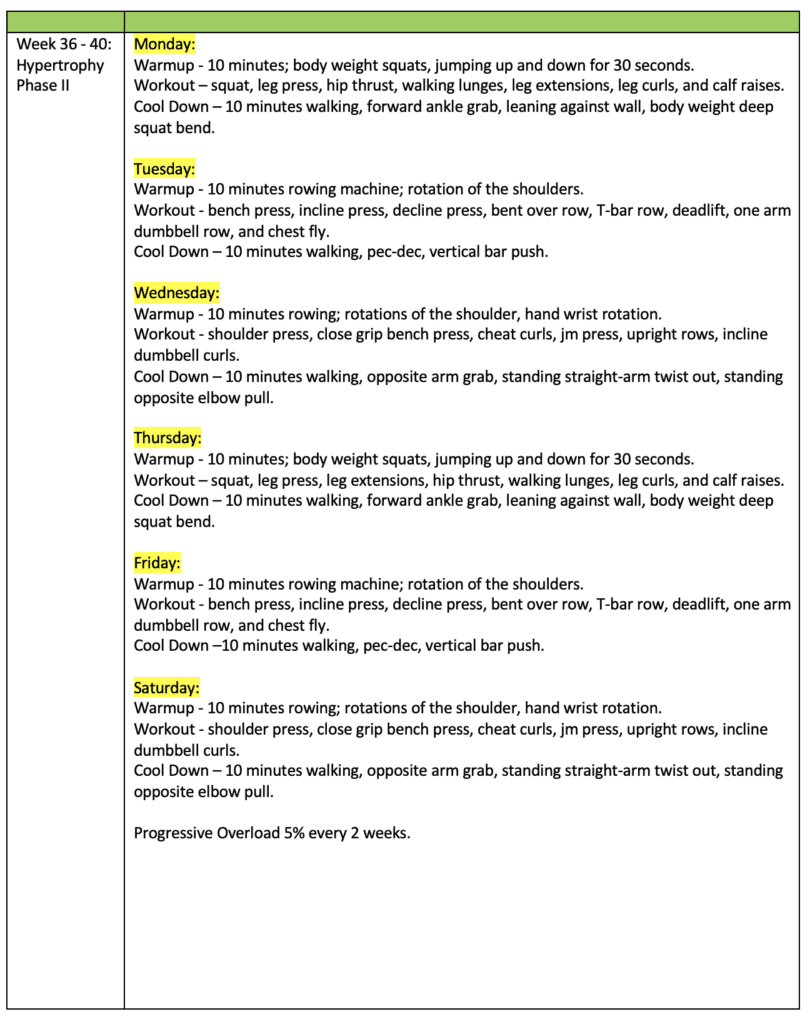
Finally, HIIT was selected for the cutting phase for the following reasons: HIIT uses high volume and short rest periods to maximize intensity during a workout and burns stomach fat while preserving muscle. In addition, HIIT works muscles by providing increased power, which exhausts muscles to the point of failure. This will cause the body to recruit more muscle fiber at the end of each exercise.
Week 41 – 46: Fat-Cutting Phase
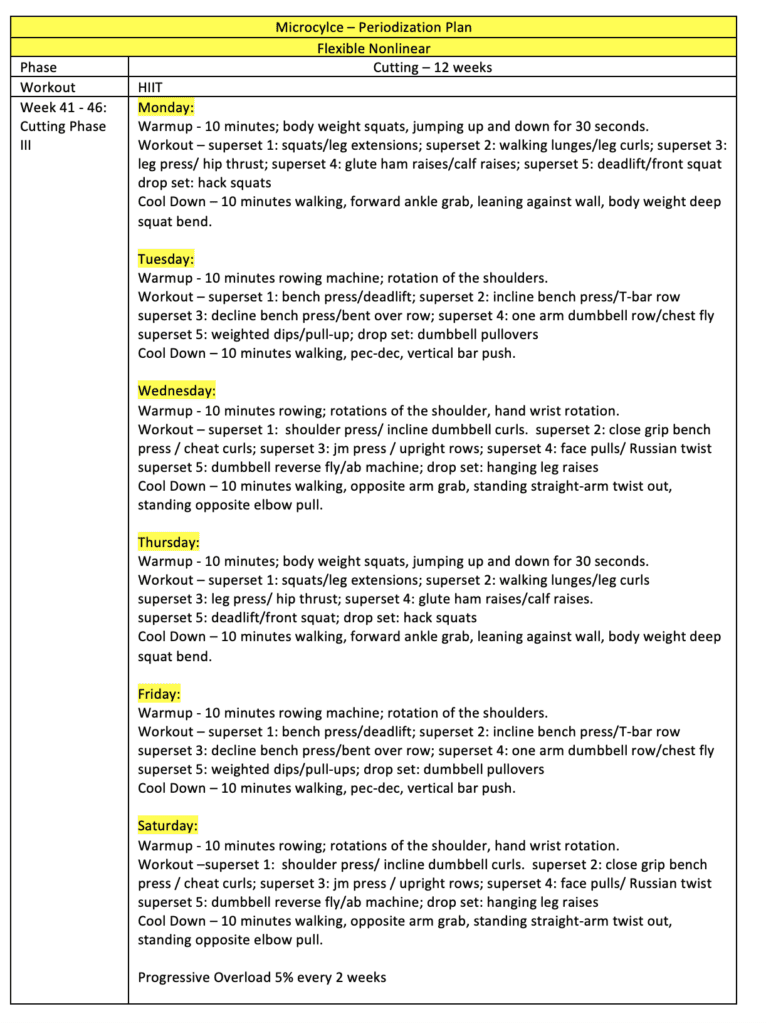
Week 47: Deload
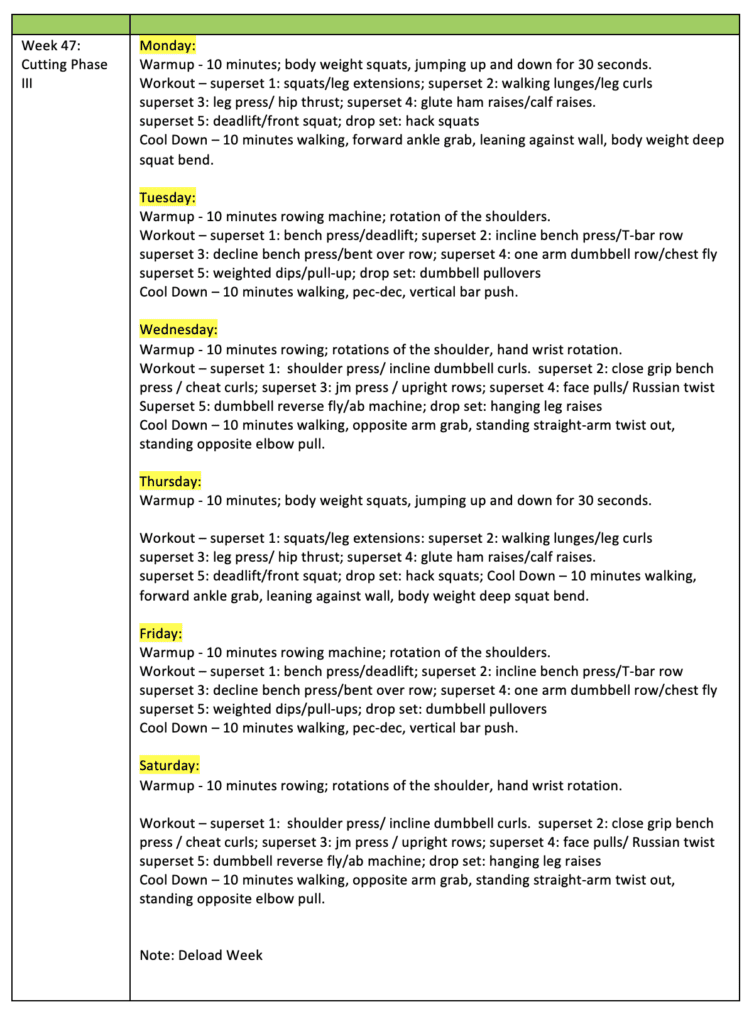
Week 48 – 52: Fat-Cutting Phase
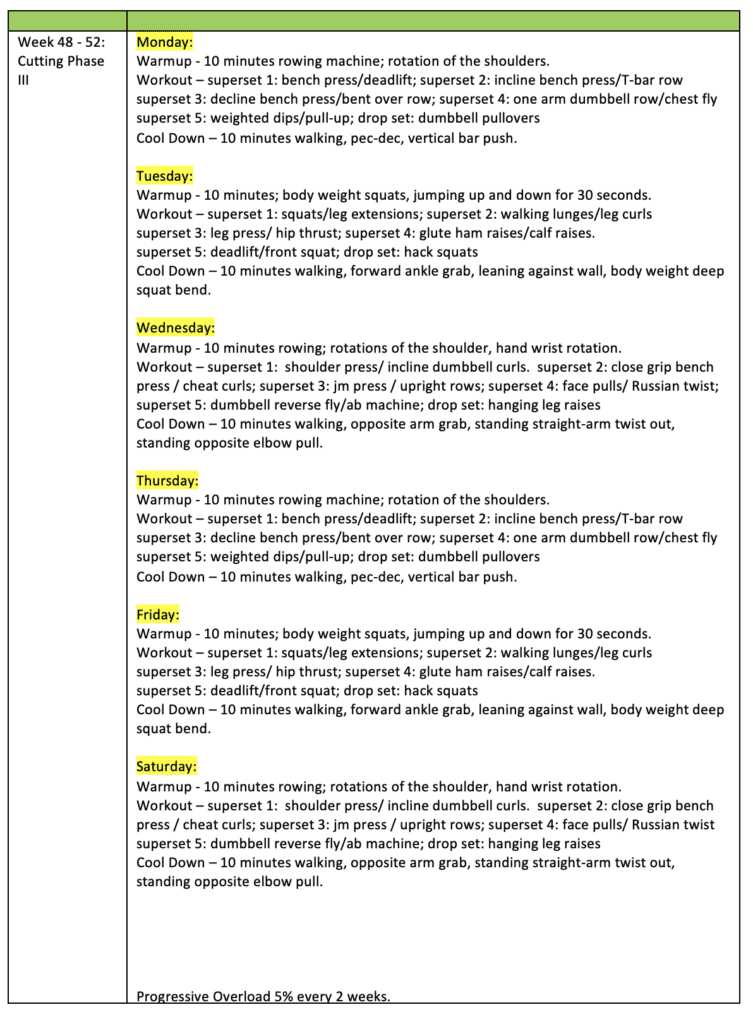
Exercise
Priority was given to compound exercises when selecting the activities for each workout program. As compound exercises recruit the most muscle fiber, build core strength, save time, and activate more anabolic hormones. The isolation exercises were selected to improve specific weaknesses as everyone has them due to incorrect training forms or genetic limitations.
Exercises were selected based on popularity and scientific research. Therefore, most activities provided in this plan were the best for each body part. Finally, exercises were chosen that the trainee performed. You know it’s best to work with activities when looking for results. Thus, strength gains are performance and not skill-based. The compound lifts used in this workout were the deadlift, squat, bench press, and others build the most muscle through muscle fiber and hormone activation.
Ronnie Coleman stated there are no surprises in bodybuilding. Everyone does the same exercises, but the best do the exercises better than everyone else. The best lift more weight and use better form. Ronnie Coleman, 8-time Mr. Olympia, was the most muscular bodybuilder when he dominated the sport of bodybuilding.
Volume
The sets, reps, and rest times were predetermined by choosing scientifically researched and well-established workout programs. Also, the workout programs dictated the weight volume for each lift. For example, it is well documented that post-exhaustion is a strength-builder workout, German volume training builds muscle, and HIIT burns the most body fat. Furthermore, the science supports the percent of one rep max used for each rep range. Thus, the meat and potatoes for a periodization plan for an amateur bodybuilder are controlled by science.
Warmup & Cool Down
After selecting the exercises, sets, reps, and rest times, the warmups and cooldowns were chosen. For the warmup, bodyweight exercises related to the workout were selected. For example, the rowing machine was chosen for back workouts, while the cycle machine was selected for leg workouts. Dynamic stretches were also chosen for the warmup to engage the muscles before working out.
For the cooldown, walking was selected as it is a compound movement that is a natural function. Also, walking is therapeutic and provides physical and mental health benefits. Static stretches were also selected to stretch the muscles that were exercised. This allows blood and oxygen to deliver nutrients to the muscle while preventing the muscle from tightening up and slowing down delayed onset muscle soreness (DOMS).
Nutrition
The nutrition plan recommended was a well-balanced diet focused on a calorie surplus for strength and hypertrophy and a calorie deficit for fat loss. The macronutrient breakdown was 50% carbohydrates and 30% proteins, and 20% fats. While calories are king, processed foods must be minimized or eliminated. Also, it is essential to note that only protein can build muscle. Thus, the literature supports one gram of protein for each pound. Fats are also necessary because they help improve hormones and break down vitamins.
Supplements
The selected supplements were protein powder, creatine, and a pre-workout energy drink. The protein powder and creatine are well-researched. While there are mixed reviews about pre-workout energy drinks, most gymgoers use them. Therefore, the benefits could be motivational, and the caffeine in most drinks will stimulate those who do not drink a lot of coffee or soft drinks. Also, the BCAAs (branch chain amino acids) or the building blocks for protein, and many the body can’t make. During the cutting phase, creatine was discontinued, and multivitamins were added. This was due to creatine retaining water. Also, a diet deficit during the cutting phase may create a vitamin intake deficiency.
Technology
Several phone apps were used to track and adjust the diet and workout program. In addition, these apps allow the trainee and trainer to share information on social media. Also, the workout app reminds the trainer of when the trainee needs to perform an exercise and rest times. Finally, MyFitnessPal, Fitness22, and MeThirtySix perform the math and produce reports so the trainee and trainer can spend time on more analytical pursuits.
The Last Word on an Example Periodization Plan for an Amateur Bodybuilder
The trainee was given a referral list before the program for services that can help their health. Bodybuilding is stressful on the body, and while trainers are knowledgeable, they are not doctors. Also, other professionals can assist bodybuilders with health maintenance. For example, many professional athletes use licensed massage therapists to perform sports massages. Bodybuilders can also purchase a tens unit, foam rollers, and other therapeutic equipment online for self-maintenance. Finally, bodybuilders should work with a doctor to monitor their health and to assist with any injuries they may get.


